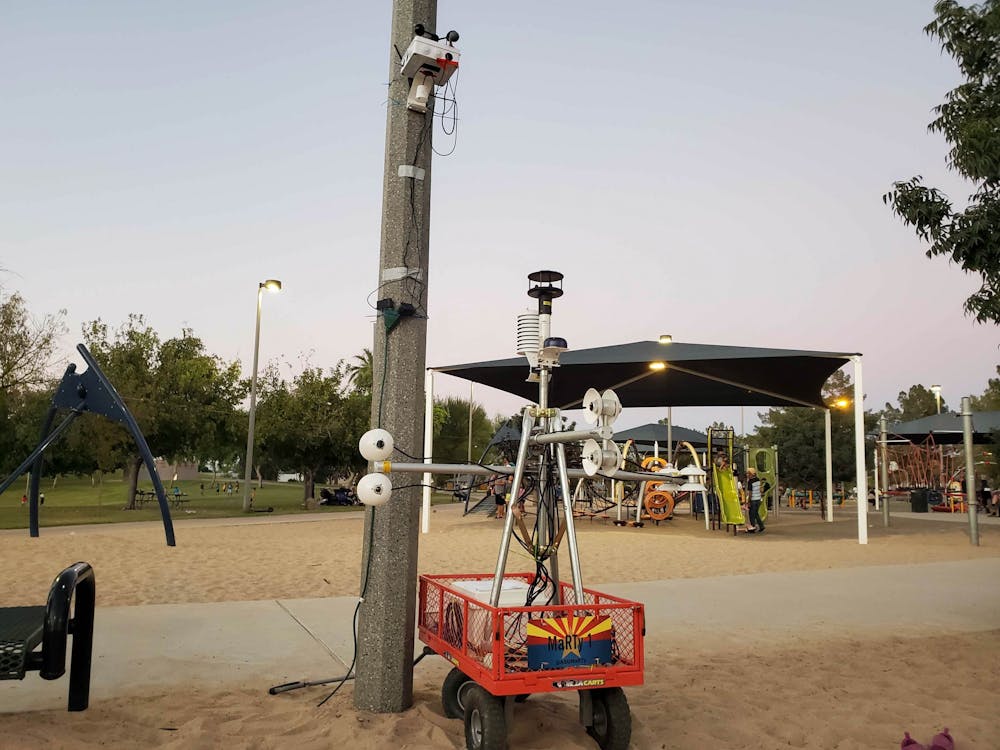From dawn 'til dusk, Florian Schneider sat and waited at Kiwanis Park on Saturday and Sunday.
With him were MaRTy and MaRTiny — biometeorological devices able to measure factors of heat: air temperature, humidity, wind speed and direction, location and more.
The devices also measure mean radiant temperature, a single number able to highlight how radiation from the sun and the hot surfaces around an individual influence the heat that people can feel at the measured location and time, said Schneider, a Ph.D. candidate at the School of Sustainability and a member of the SHaDE Lab at ASU.
For Schneider, the location provided the opportunity to test MaRTiny for the first time in the field, and being there all day would show how measurements of those variables change over the course of time.
MaRTy has been key to the research of Ariane Middel, an assistant professor at the School of Arts, Media and Engineering who studies urban climate and shade and works frequently with the city of Tempe on parts of its Climate Action Plan.
MaRTy's device and its sensors are set up in a cart, making it mobile. But despite its wheels, MaRTy is still heavy and bulky. It's also expensive, with a price of around $20,000. And further, it is limited to the area it can cover in one day to record data.
"The idea was to create something that is more affordable, smaller and easier to transport," Middel said. These ideas resulted in MaRTiny.
Technologically, MaRTiny is very similar to the original MaRTy. They both record most of the same measurements. However, Schneider said, there are key differences between the two: MaRTiny is not mobile, it is smaller, it costs 1 to 2% of MaRTy's price, it can connect to Wi-Fi and provide data every minute, and it features a camera that can record the data from a livestream to measure if people captured in its frame are in the sun or in the shade.
Middel said city officials wanted to know how people were using spaces, especially when it is hot.
"We thought that if we could add a webcam to the MaRTiny, we could determine how many people are using the shade and other areas," Middel said.
MaRTiny also features what is essentially a globe thermometer, a type of thermometer that measures air temperature and the radiation from a hot or cold surface, using a ping pong ball spray-painted gray, Middel said. Using this, the globe temperature can be obtained and be translated to the mean radiant temperature.
The hope is that if MaRTiny can produce data that is as accurate as that of MaRTy, it can be placed throughout neighborhoods to gather heat data. With the device being small and portable, and the fact that it is significantly cheaper, MaRTiny could be mass-produced. Its use in neighborhoods could provide data to the citizens to determine what is hot and what is not, Schneider said.
Using the webcam, the MaRTiny runs a programmed device that accumulates data in two directions, developed by recent ASU graduate Karthik Kulkarni, who studied computer engineering.
One part of the program determines the weather aspects of the MaRTiny to determine the shaded and sunny areas. The other counts the people who are in the shaded areas, those who are not and at which times of the day all of this occurs.
It then takes the data of those results, while discarding the actual video footage, and stores it at the online database at Amazon Web Services. Over time, MaRTiny will use that information to learn and evolve in order to produce more accurate data. This is what is known as machine learning.
"In order to make it as accurate as possible, we ran multiple tests in the lab in different places where we set up the systems where we checked the values and the machine learning model," Kulkarni said. "The model learns better and better as it assimilates more data."
As Schneider sat at the park, he checked his phone for data from MaRTiny, which was hooked up to the phone through a hotspot. In real time, he was able to check whether the device was working.
"The hope is that we can connect the dots," Schneider said. "We have the meteorological data, the micro-scale data of how hot it is, how hot it feels. And we have the information of 'How do people use space at this time, considering the conditions and does that change at different times of day?'"
Reach the reporters at wmyskow@asu.edu and ljchatha@asu.edu and follow @wmyskow and @LukeJC2 on Twitter.
Like The State Press on Facebook and follow @statepress on Twitter.
Continue supporting student journalism and donate to The State Press today.

Wyatt Myskow is the project manager at The State Press, where he oversees enterprise stories for the publication. He also works at The Arizona Republic, where he covers the cities of Peoria and Surprise.

Luke Chatham is a Community & Culture reporter and previous Business and Tech reporter. He also worked in the studio production crew for Cronkite News and is currently a freelance reporter and writer for Arcadia News.




